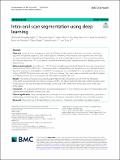Intra-oral scan segmentation using deep learning
Author(s)
Vinayahalingam, Shankeeth; Kempers, Steven; Schoep, Julian; Hsu, Tzu-Ming H.; Moin, David A.; van Ginneken, Bram; Flügge, Tabea; Hanisch, Marcel; Xi, Tong; ... Show more Show less
Download12903_2023_Article_3362.pdf (1.913Mb)
Publisher with Creative Commons License
Publisher with Creative Commons License
Creative Commons Attribution
Terms of use
Metadata
Show full item recordAbstract
Abstract
Objective
Intra-oral scans and gypsum cast scans (OS) are widely used in orthodontics, prosthetics, implantology, and orthognathic surgery to plan patient-specific treatments, which require teeth segmentations with high accuracy and resolution. Manual teeth segmentation, the gold standard up until now, is time-consuming, tedious, and observer-dependent. This study aims to develop an automated teeth segmentation and labeling system using deep learning.
Material and methods
As a reference, 1750 OS were manually segmented and labeled. A deep-learning approach based on PointCNN and 3D U-net in combination with a rule-based heuristic algorithm and a combinatorial search algorithm was trained and validated on 1400 OS. Subsequently, the trained algorithm was applied to a test set consisting of 350 OS. The intersection over union (IoU), as a measure of accuracy, was calculated to quantify the degree of similarity between the annotated ground truth and the model predictions.
Results
The model achieved accurate teeth segmentations with a mean IoU score of 0.915. The FDI labels of the teeth were predicted with a mean accuracy of 0.894. The optical inspection showed excellent position agreements between the automatically and manually segmented teeth components. Minor flaws were mostly seen at the edges.
Conclusion
The proposed method forms a promising foundation for time-effective and observer-independent teeth segmentation and labeling on intra-oral scans.
Clinical significance
Deep learning may assist clinicians in virtual treatment planning in orthodontics, prosthetics, implantology, and orthognathic surgery. The impact of using such models in clinical practice should be explored.
Date issued
2023-09-05Department
Massachusetts Institute of Technology. Computer Science and Artificial Intelligence LaboratoryPublisher
BioMed Central
Citation
BMC Oral Health. 2023 Sep 05;23(1):643
Version: Final published version